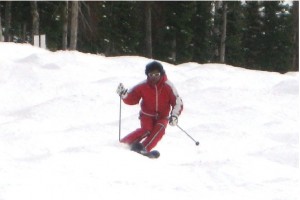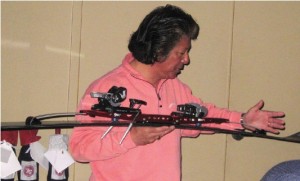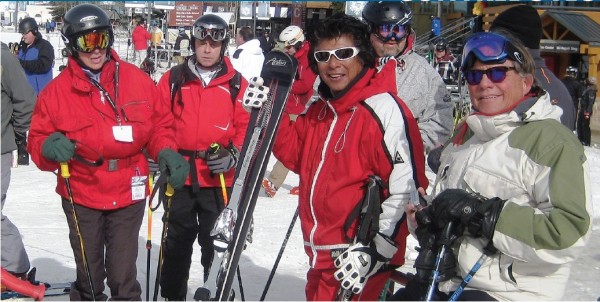by Ed Kane
Last season I was at Winter Park resort with the North American Ski Journalists. I got there just as the SIA on snow demos were ending and just before a storm blew in so that we could enjoy some new snow over packed powder. The highlight of the trip, however, was the opportunity to spend the day with a role model from the past and to try out what could turn out to be the next advancement in ski technology. The role model is Wayne Wong and the new twist in skis is the “Anton Ski Active Suspension System.”
I started skiing seriously in the early 1960s and started teaching in the mid 60s. This was a very creative time period in the history of skiing in the US. PSIA was becoming actively involved in creating guidelines and materials that would unify the teaching approach throughout the country and the world was becoming aware of our instructional philosophy through our involvement in the semiannual international Interski meetings. Skiing for the general public was also beginning to mature and grow through the influence of magazine publications, films and TV. In this latter venue much of the material was provided by a small group of very imaginative and high energy skiers known at that time as “Freestylers.”
 One of the most colorful of these was Wayne Wong a Northwestern native (if you count BC as part of the Northwest). His long black hair, sun glasses, bandanna, winning smile and flashy skiing caught the imagination of the skiing public including me. I spent a lot of time in the early ‘70s trying to master his style and tricks (the worm turn was about my only success). Wayne was Certified by the Canadian Ski Instructors Alliance at the age of 16 and in 1975 he was part of the Canadian Inter-Ski Demo team. He won the first “Freestyler of the Year” award in 1972, was Europa Cup champion in 1973, Rocky Mountain freestyle champ in 1973 and Japan International Freestyle champion in 1975. If you check out the latest Winter 2011 issue of 32 Degrees you’ll see some vintage photos of that era. He was inducted into the Canadian Ski Hall of Fame in April 2009 for his influence on skiing culture. Wayne continues to be actively involved in the ski industry and hasn’t lost much of his ability, stability and flash over all the years as can be seen in the accompanying photos. It was truly a memorable experience skiing with him for the day.
One of the most colorful of these was Wayne Wong a Northwestern native (if you count BC as part of the Northwest). His long black hair, sun glasses, bandanna, winning smile and flashy skiing caught the imagination of the skiing public including me. I spent a lot of time in the early ‘70s trying to master his style and tricks (the worm turn was about my only success). Wayne was Certified by the Canadian Ski Instructors Alliance at the age of 16 and in 1975 he was part of the Canadian Inter-Ski Demo team. He won the first “Freestyler of the Year” award in 1972, was Europa Cup champion in 1973, Rocky Mountain freestyle champ in 1973 and Japan International Freestyle champion in 1975. If you check out the latest Winter 2011 issue of 32 Degrees you’ll see some vintage photos of that era. He was inducted into the Canadian Ski Hall of Fame in April 2009 for his influence on skiing culture. Wayne continues to be actively involved in the ski industry and hasn’t lost much of his ability, stability and flash over all the years as can be seen in the accompanying photos. It was truly a memorable experience skiing with him for the day.
The reason we were able to spend the day with Wayne was that he is promoting a ski line that is viewed as the next step into the future of skiing. He and Anton Wilson were at Winter Park for the SIA show demonstrating their new line of skis (www.antonskis.com). To be perfectly correct, they would be better described as a ski with a built in suspension system shown in the photo below. This was developed by Anton in an effort to get a better ride on skis and to enable the user to more easily make carved turns. The ski is a shaped wood core wet glass wrap which is quite soft in both flex and torsion. A suspension system is mounted to this ski which consists of an adjustable base plate upon which the bindings are mounted and a composite spring system anchored near the tip and tail of the ski. The base plate can be adjusted to put more load into the tip and tail which also increases the camber of the unloaded ski. The combination is an adjustable ski with a range of characteristics intended to make the ride smother and keep more of the ski in contact with the snow especially while turning.
 We got to spend the day skiing with Wayne and Anton exploring the design on the groomed runs, in the trees and in the bumps. During that time, Wayne spent time coaching some of the group on achieving more efficient movements to get more performance out of the skis. Midway through the day we started to play with the adjustment mechanism so that we could experience the performance differences. I found that on the softest setting the system was quite responsive and very stable at moderate speeds on soft snow and in the bumps. The turns for the most part were carved and required very little in the way of extreme stances or movements to hold a nice arced turn. However, at higher speeds on steeper terrain they tended to be a bit unstable, chattered a bit and it was difficult to hold the intended line. In the afternoon, after increasing the stiffness through the adjustments in the suspension system these latter turns in the steeper terrain were much more comfortable.
We got to spend the day skiing with Wayne and Anton exploring the design on the groomed runs, in the trees and in the bumps. During that time, Wayne spent time coaching some of the group on achieving more efficient movements to get more performance out of the skis. Midway through the day we started to play with the adjustment mechanism so that we could experience the performance differences. I found that on the softest setting the system was quite responsive and very stable at moderate speeds on soft snow and in the bumps. The turns for the most part were carved and required very little in the way of extreme stances or movements to hold a nice arced turn. However, at higher speeds on steeper terrain they tended to be a bit unstable, chattered a bit and it was difficult to hold the intended line. In the afternoon, after increasing the stiffness through the adjustments in the suspension system these latter turns in the steeper terrain were much more comfortable.
On the whole, the ski/suspension system seems to perform as described by Wayne and Anton. It is likely that, if these catch on, the general public may find something of this nature a less challenging way to experience efficient skiing movements early in their learning experience. Such innovations may be able to bring more growth and retention in the skiing population. However it must be noted that currently these skis are in the “designer” category of skis due to their high price point which is driven primarily by the intensive touch labor required to install the suspension system. I for one will watch the development and acceptance of these in the market place. In the meantime, I was lucky enough to spend the day experiencing a hint of the future.
[connections_list id=90 template_name=”div_staff_bio”]

